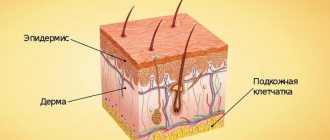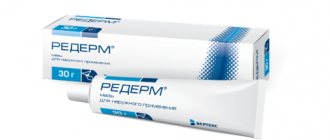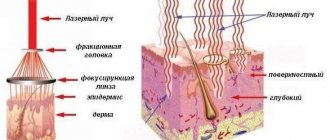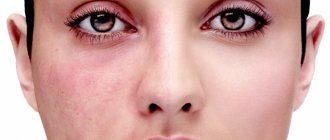Diathesis is a controversial concept. In modern domestic pediatrics and therapy, this concept is no longer used in everyday practice. Diathesis is essentially the body’s predisposition to the development of certain pathological reactions. Diathesis is also called constitutional anomalies. Previously, three types of diathesis were distinguished: exudative-catarrhal, lymphatic-hypoplastic, neuro-arthritic. Each of them included certain criteria. Exudative-catarrhal diathesis is characterized by a person’s tendency to allergies and the development of infectious diseases. Lymphatic-hypoplastic diathesis is characterized by excess weight, enlarged lymph nodes, enlarged tonsils and adenoids. Such children often suffer from respiratory diseases and are also prone to allergies. Neuro-arthritic diathesis is characterized by changes in metabolism caused by increased excitability of the nervous system. Such people often experience pain in the knees and back, urinary incontinence, night terrors, decreased appetite, emotional instability, and stuttering. It is worth emphasizing that the most characteristic symptom of this disease is cyclically occurring vomiting (the so-called acetonemic syndrome in children). The described symptoms of diathesis often occur in childhood, so these manifestations are less pronounced in adults.
Using the term “diathesis” nowadays, pediatricians and therapists often mean exudative-catarrhal diathesis, which has a more modern concept – “ atopic dermatitis”. Therefore, further consideration of this topic will be devoted to this particular disease.
Diathesis and its causes
Atopic dermatitis (diathesis) is the most common allergic skin disease in children and adults, which is characterized by inflammation, itching, and a chronic relapsing course. Atopic dermatitis typically has different skin manifestations depending on the person's age. Let's look at it in more detail below.
Atopic dermatitis (diathesis) is the most common allergic skin disease.
Causes of diathesis
A special role in the development of the disease is played by the hereditary ability to develop allergic diseases.
The disease is also based on other causes, which can be divided into internal and external. Internal characteristics include the characteristics of the organism itself. External causes include those with which a person comes into contact from the outside.
Internal reasons
- Hereditary – determined ability of the body to increase the production of IgE (immunoglobulin, responsible in most cases for allergies).
- Increased, excessive reaction of the skin to irritants (allergens).
- Increased skin dryness.
- Violation of the epidermal barrier.
External reasons
- In children of the first years of life - food allergies, as well as intestinal dysbiosis, vaccination (DPT). It is important to emphasize that vaccination will not lead to the development of atopic dermatitis in every child. There is only a higher likelihood of developing this disease in children with a history of allergies.
- Preschool children have household and fungal allergens. Often the cause can be helminthiasis.
- In adolescence – stress, emotional experiences.
- The causes of diathesis in adults are a combination of the factors described above. This could be a food allergy, an allergy to flowering plants, a contact allergy (when allergens come into contact with the skin), stress, or emotional distress.
Correction methods
Any cosmetic defect, especially noticeable and causing a lot of inconvenience, needs to be eliminated. You can get rid of orange peel on your face using several techniques. But which method is suitable in a particular situation, it is necessary to understand with the participation of a specialist.
Facial care
Proper facial skin care is of decisive importance in the structure of cosmetological correction. Those suffering from increased oiliness and a tendency to acne need to pay attention to a number of points:
- Wash with special cleansing gels.
- Use scrubs (once every 10 days).
- Apply moisturizing creams.
- Always remove makeup (do not leave it on overnight).
- Do not get carried away with alcohol-containing products.
Skin care requires an integrated approach, which includes cleansing pores of fat and impurities, exfoliating the stratum corneum, and moisturizing. The selection of cosmetics must be approached very carefully, avoiding comedogenic components.
Symptoms of diathesis in children and adults
Diathesis can appear at any age. The main manifestation is constant severe itching in combination with local skin manifestations . The disease is characterized by a relapsing course.
Diathesis can appear at any age.
The first signs of the disease appear at an early age. They are preceded by the appearance of scales on the scalp and eyebrows (gneiss). One of the main and main manifestations of dermatitis in young children is redness and dryness of the skin of the cheeks. A characteristic feature is that the nasolabial triangle and nose remain untouched by allergic rashes. If parents do not take any measures, the process progresses. Lesions also appear on other parts of the body: scalp, ears, torso, extensor surfaces of the limbs. Often the rash can be located on the buttocks, around the anus. Without treatment, the process progresses, and small blisters appear against the background of redness and swelling of the skin, which quickly collapse. As a result, wounds appear that become covered with crust and scales. After peeling off the crusts, smooth, bright pink skin remains at the affected areas. Sometimes, against the background of the described rash, small nodules may also appear on the skin, which rise above the skin level. on the skin are usually located symmetrically .
With age, many patients experience clinical transformation of skin rashes. In adults they look different and are located in different places. The lesions look like thickened and dry skin. They are located on the neck, elbow and popliteal folds, on the back of the hands, in the axillary and inguinal folds, sometimes around the mouth, eyes and in the genital area. Characterized by intense itching of the skin, which intensifies at night. Because of this, sleep is disturbed, the person becomes irritable and moody. Constant itching leads to the fact that a child or adult scratches dry areas of the skin and a wound surface appears that becomes covered with crusts.
Who invented cellulite and how to fight it (and is it necessary): experts debunk myths
Publication date: July 07, 2022.
According to doctors, the term “cellulite” in medicine means inflammation of the subcutaneous fat and requires treatment. And the phenomenon that in everyday life we are accustomed to calling cellulite, in most cases, is a secondary female sexual characteristic that does not affect the health of the body as a whole. It occurs in approximately 80-98% of women and a much smaller percentage of men. We decided to delve into the history of the issue and figured out the nature of this phenomenon, and experts debunked popular myths about the “orange peel.”
Half a century ago, no one in the world had even heard of cellulite, let alone considered it a problem that needed to be addressed immediately. Today we spend thousands, if not billions (globally) on anti-cellulite treatments and products. It is important to understand that cellulite is normal, and it occurs even in professional athletes. However, the desire to reduce its manifestations and smooth out the relief is also an absolutely normal process: all points of view are good if they lead to harmony of body and mind. In other words, if the bumps are still annoying, then you can smooth them out, but you shouldn’t follow the imposed stereotypes and compare yourself with Instagram models photoshopped to unrealistic proportions.
Background
In April 1968, Vogue became the first English-language publication to use the term “cellulite” on its pages. This word was originally coined in France. It was first mentioned in a French medical dictionary in 1873 by doctors Emile Littre and Charles-Philippe Robin. This was the first use of the term, according to Professor Rossella Ghigi, whose dissertation on the history of cellulite is perhaps the most detailed and comprehensive work ever written on the subject.
However, the original (and accurate) definition of cellulite had nothing to do with fat. It was a general term applied to cells or tissues in a state of inflammation or infection. It designated a diagnosis that is still used today (and also has nothing to do with dimples on the buttocks). It is a deep inflammatory lesion of the skin and subcutaneous tissue, accompanied by redness, swelling and pain. Cellulite is usually caused by bacterial flora - group A streptococci and attached Staphylococcus aureus.
The term "cellulite" quickly migrated from medical textbooks into the mainstream lexicon at the turn of the century, losing its true meaning along the way. It began to be considered a disadvantage in the interwar years, when Paris consolidated its title as the capital of fashion. Professor Holly Grout explores this phenomenon in her book The Power of Beauty: The Transformation of French Ideas of Femininity in the Third Republic, which states that the first of the legendary French beauty institutes opened in 1895, with many others soon following. Many new specialists, dermatologists, massage therapists and even doctors have appeared in beauty salons.
There were no clear boundaries between beauty, science, medicine and health. Today it can be called the health industry,” he said.
As often happens during war, many traditional gender roles disappeared. As men went to the front, more and more women had to become independent. They took high-paying jobs in traditionally male-dominated industries.
After the war, Grout says, a new archetype of modern femininity emerged: the woman was self-sufficient and free from the constraints of class inequality. More and more women began to work, more and more women began to appear in the media, in advertising and on stage.
People began to actively talk about cellulite since the 20s of the 20th century. Then for some time the world had no time for women’s buttocks, and marketers really took up this new niche in America in the 70s,” says Yulia Shuvalova, cosmetologist, dermatovenerologist at the Gen87 innovative cosmetology clinic.
The term "cellulite" began to be widely discussed after an article was published in the French magazine Votre Beauté in February 1933. In the article, Dr. Debeck described cellulite as a combination of water, toxins and fat that is nearly impossible to get rid of. In addition, he added, this is a purely “women’s” problem.
Why he chose this particular term, we will never know. Previously, cellulite, of course, was not considered something that needed to be gotten rid of. Just look at almost all the paintings of the 17th century. Painters such as Rembrandt, Rubens and Courbet admired the irregularities on women's buttocks, thighs and abdomen. But after the 1933 article, French spas began advertising treatments to get rid of cellulite, including special soaps, massages and cosmetics.
The new canons of female beauty that emerged at the beginning of the First World War became full-fledged beauty standards after the Second World War: the hourglass figure came into fashion, and ladies pulled themselves into corsets to emphasize their thin waists.
The boom in facial care cosmetics came a little earlier, in the 50s, when American women began to actively go to work, which required them to look young and fresh. Since the mid-60s, miniskirts have appeared, and with them the opportunity to look at your own and other people’s legs. The logical step in the development of the beauty industry was the “anti-cellulite” bombardment of women’s heads, notes Gen87 expert.
And retouching photographs in gloss to the ideal skin tone has finally destroyed the criterion of normality for the presence of relief on the hips.
Comparing yourself with a glossy, ideal two-dimensional picture often does not add confidence, which is why the more real unretouched photographs appear in the information field, the more harmonious the attitude towards the body will be among women, says Yulia Shuvalova.
Then, in the 60s, diets came into fashion. Even now, Fischler notes, being thin is considered a personal achievement for some.
“Being fit and slim is still considered by some to be a matter of self-discipline, dedication, courage,” he says.
A curvy figure was once a sign of wealth and energy in the body, but after World War II it began to be considered a “useless burden.” Obesity was now a symbol of weakness, laziness and even immorality. It was a personal failure,” writes the researcher.
This is how the new standard of female beauty took root in the Western world.
“Cellulite: The Fat You Couldn't Get Rid of Before,” read the headline of a 1968 Vogue article introducing American women to the concept.
The article talked about a young woman who was able to get rid of cellulite through exercise, diet and special self-massage. In 1973, the enterprising owner of a New York beauty salon, Nicole Ronsard, published the book Cellulite: Those Lumps, Lumps and Lumps You Couldn't Get Rid of Before. She actively advertised the services of her salon, which ultimately turned out to be ineffective. After this, the myth about cellulite took root in the minds of women, along with invented reasons for its occurrence and miracle cures.
What is cellulite?
Let's start with what subcutaneous fatty tissue (SFA) is. It consists of “balls”, “ovals” (of different diameters), penetrated by blood and lymphatic vessels and nerves. On top it is covered with skin, which is structurally much denser, especially in the upper layers, and consists of cells of more or less equal size. That is, dense skin covers a soft cellular layer.
Accordingly, the more subcutaneous fat a person has, the more bumps and dimples there are on the skin. If we have a person with excess body weight (body mass index - 25-30) or with obesity, for example, the first degree (body mass index - more than 30), then where the largest deposits of the fatty acids are located (usually the hips, abdomen, buttocks, shoulder), the skin will be the most uneven, with an abundance of tubercles and dimples,” explains Maria Selikhova, head of the expert center for women’s health, obstetrician-gynecologist, endocrinologist, hemostasiologist at the REMEDI clinic.
According to statistics, almost 90% of women have cellulite. Despite hundreds of studies, there are many myths about what it is, what causes it, and how to get rid of it. They asked experts to debunk them.
Myth: Cellulite is not ordinary fat.
Let's start with the fact that cellulite is not a medical term. What we used to call cellulite is a layer of fat enclosed in “cells” formed by fibers. They connect the skin to deep tissues. As cosmetologist, body correction specialist at the LazerJazz clinic Anastasia Tselishcheva explains, when fat cells increase in volume, these “cells” become more pronounced.
However, according to research results, normal subcutaneous fat and subcutaneous fat taken from the area with cellulite are identical in structure.
Despite the fact that cellulite is not a disease, the current fashion for ideal, smooth skin causes numerous complexes in women and stimulates them to search for various methods to combat it, says the expert.
Myth: Cellulite only affects women
Why does “orange peel” on the thighs occur mainly in women, although it also occurs in men? It's all about the structure of female subcutaneous fat and the presence of the hormone estrogen. It promotes the accumulation of fat in the buttocks and thighs. This is why cellulite occurs not only in overweight women.
The structural features, physiology and hormonal regulation of subcutaneous fat in women suggest a greater tendency to accumulate fat than in men, since female adipocytes have a larger number of receptors responsible for lipogenesis, says Gen87 expert.
However, the more fat there is in the “cells”, the more visible these cells are. Also, if there is insufficient blood circulation in this area, fluid accumulates, which aggravates the situation.
Myth: The appearance of cellulite is caused by toxins in our body.
Some cellulite remedies are aimed at removing toxins from the body. However, their effectiveness is not supported by science. According to New York City dermatologist Cheryl Karcher, connective tissue can be weakened by hormones, lack of exercise and muscle tone, excess fat and poor circulation, but certainly not by a buildup of toxins.
Myth: Cellulite only appears on those who are out of shape.
Indeed, the more fat there is under the skin, the more likely it is that it will put stress on the connective tissue and cellulite will become more noticeable. However, orange peel occurs in women of all shapes and sizes. Yes, even Victoria's Secret models who are very thin exercise a lot and eat right.
You don't have to be overweight or have a lot of body fat to have cellulite. But in addition to the aesthetic aspect, it is very important to understand that excess weight puts an additional burden on the cardiovascular system. And in general, the quality of life of an obese person worsens. Cellulite does not pose any harm to health. The canons of beauty in different eras are different, but the principles of health are practically unchanged, says Nino Bigvava-Abbas, dermatocosmetologist at the Bellefontaine clinic.
As for pregnancy, during this period the number of sex hormones and their receptors increases sharply. As pregnancy progresses, stagnation in the subcutaneous fat tissue (fluid retention) progresses. Accordingly, cellulite in pregnant women is explained physiologically, notes Maria Selikhova.
Myth: Cellulite appears if you eat dairy products. In fact, everything is very individual. For some, dairy products may contribute to the development of cellulite, but for others not. After a certain age, some people's bodies stop absorbing milk, while others enjoy it until they are very old.
Sweets, like other foods that promote fat storage, can have an effect. Sweets, fatty foods, flour foods, and a sedentary lifestyle aggravate cellulite, but the reason for the appearance of cellulite is the structure of fatty acids and estrogen, the expert notes.
Myth: Predisposition to cellulite is genetic
But on this matter, expert opinions differ. Some believe that even a genetic test can show a predisposition to cellulite. On the other hand, genetics is only one small piece of the whole puzzle. Factors such as diet, exercise and maintaining a healthy weight also play a role. I have not heard that scientists have identified a specific gene responsible for cellulite. But if we remember that cellulite, “orange peel”, is an external manifestation of processes occurring in the body (for example, stagnation of lymph due to structural features of the body, hormonal disruptions and changes), then it is quite obvious that these and other factors can be transmitted through inheritance,” says the dermatocosmetologist at the Bellefontaine clinic.
Myth: Firming creams will help get rid of cellulite
The appearance of cellulite is preceded by various factors, for example, hormonal imbalance or lymph stagnation (genetic predisposition, lifestyle). And it would be somewhat naive to believe that one miracle cream will save you from cellulite. But, of course, well-chosen home care will preserve and enhance the effect of salon procedures.
Research has shown that creams or scrubs with caffeine, ginger, green or black tea can also (key word!) help by improving circulation and breaking down fat cells.
Methods of prevention To prevent cellulite, an integrated approach is important. For example, massages can be done not as a course, but on a regular basis. According to doctors, regular massage improves the flow of lymph and blood, which has a beneficial effect on the entire body and significantly affects the appearance of the skin.
Mesotherapy works very well together with hardware cosmetology. The Harmony XL laser with the Clear Lift attachment shows amazing results. The device works in the deep layers of the skin and does not damage the surface layer - the epidermis. There is no rehabilitation and a quick visible effect: the skin tightens, the “lumpyness” goes away. We must not forget about wraps; microcurrents - course procedure; contrast shower - for general toning of the body and improving blood flow, advises Nino Bigvava-Abbas.
Ways to fight
Sport
The article was published in the magazine Spletnik.ru
The first thing that comes to mind is sports. It really helps reduce the appearance of cellulite, provided that the person loses weight, no matter what kind of load it is: cardio or strength exercises. The main thing is to reduce the volume of PFA.
Hardware procedures
The most popular procedures to combat cellulite are LPG, anti-cellulite massage, body wraps. These procedures improve blood flow in the tissues, which helps remove excess fluid and improve the quality of the skin. Due to these two effects, cellulite will actually become less noticeable. However, these procedures do not solve the problem itself, because the fat still remains in the same volume in its place, comments the LazerJazz expert.
A relatively new procedure for reducing local fat deposits using the Ulfit device, the effect of an ultrasonic wave, ensures the destruction of fat cells, strengthening the ligamentous apparatus of the skin and tightening the skin itself, that is, it solves all three problems of the appearance of cellulite.
If you need to thicken and strengthen the skin, thin out the fat layer, then you can undergo a course of procedures using the Accent device, and if you need to specifically remove the fat trap (the place where fat accumulates especially easily and is difficult to correct with nutrition and exercise), then cryolipolysis using the Clatuu device will help .
To love and be grateful to your body, you need to take care of it, give yourself adequate sleep, nutrition and exercise, says Gen87 expert.
Injections
Mesotherapy with lipolytic cocktails improves blood flow, reduces fatty acids and tightens the skin. This procedure can reduce the signs of cellulite, but there are disadvantages - pain and possible bruising.
Massage
Massage is one of the most effective and important techniques that works not only the skin and subcutaneous fat, but also muscles and ligaments. You can do it yourself or trust a specialist. It is also important what the massage is performed on.
The most popular spa program in our network is “Minus 7 Centimeters” using Gold Shape cream, which set a world record in figure correction. Thanks to the extracts from Thai tropical plants such as gingko biloba, cola, ginger and red capsicum included in the cream, volumes are reduced, and the skin becomes smooth and elastic, say experts at the 7 Colors salon.
The massage can be general or local - special emphasis is placed on certain areas. To obtain and consolidate positive results, masters recommend undergoing a course of massages at three to four-day intervals, combining it with a special Thai massage technique and wraps (for example, seaweed wraps with live kelp).
Self-massage with a brush made of natural bristles (cactus or boar bristles) or drybrushing will also not be superfluous. It should only be done on dry skin before taking a shower. Starting from the feet, we move up the legs using rubbing movements (we go through each section 10 times). Then, in a circular motion, we “treat” the knees (it’s better not to touch the area under the knee), thighs, buttocks, stomach, sides, and don’t forget about the arms and forearms. The most delicate area is from the shoulder to the center of the neckline. Movements should be smooth and gentle. After the massage (it takes 10-15 minutes), take a shower and apply moisturizing lotion or oil.
Diagnosis of diathesis
In order to make a diagnosis of atopic dermatitis, you must have:
- Allergy burden.
- A typical rash, which is located in typical places.
- A clinical blood test shows eosinophilia (increased levels of cells responsible for allergies).
- An increase in the blood level of allergen-specific IgE antibodies, which also increase with allergies.
- Positive skin tests with allergens (so-called “prick tests”). They are the gold standard in confirming allergies. The essence of the method is that a healthcare worker applies small punctures with allergens to the patient’s skin and evaluates the reaction. If a reaction occurs, the test can be considered positive.
How to get rid of orange peel?
Of course, if your budget allows, you should go to a beauty salon and use such effective procedures as deep peeling or laser facial resurfacing.
However, some cosmetologists believe that home remedies are not only not inferior in quality, but are often more effective than salon procedures. At the same time, everyone can afford such funds - you don’t have to spend serious money.
offer
How to remove orange peel from facial skin? We offer several effective recipes:
- Pour a tablespoon of linden flowers into 100 milliliters of hot water. Don't use boiling water - just hot water! Place the mixture on the stove and wait until it thickens. When this happens, allow the mass to cool, and then safely apply it to the skin. After 20 minutes, remove the mask with a cotton pad, then carefully wash with cool running water. It is important not to rub your face while washing.
- Buy bread made from black flour and soak a small amount of it in plain water. Apply the mixture for 15 minutes, after which you can rinse with cool water.
- Crush the pulp of one orange with a spoon and apply this mixture to your face. Lie with it for about 15 minutes, rinse with water, and then use a moisturizer.
- Take a not very large grater and grate one raw potato. Add one egg to the mixture, mix everything and apply to the skin of the face. After 30 minutes, the mask can be washed off.
- A paste of fresh tomatoes will also help tighten your pores if you apply it for about half an hour.
- Another version of the above mask with tomatoes. It stays on the face for the same amount of time, but only the tomatoes are cut into rings.
- If you have oatmeal at home, you can use it to cleanse your pores of impurities. Simply soften the flakes in water and apply to problem areas for 20 minutes. Washing with oatmeal is also useful.
- You can use coffee grounds as a scrub. It must be applied to the skin, gently rubbed over the face, then rinsed off.
- To tighten the pores, lemon zest, grated and mixed with olive oil, is also suitable. However, this recipe is not suitable for everyone. If irritation occurs after applying the mask, it is better to discard it and use another product.
Features of thin skin
If you study the properties of the skin, thin skin resembles dry skin. But there are certain individual characteristics. You can recognize thin facial skin by certain signs:
- there is no shine or greasy film on the face;
- has a matte velvety structure;
- the surface is smooth and does not contain enlarged pores;
- too tight, dry and flaky;
- there are capillaries near the surface, so the face may often turn red;
- due to insufficient amount of melanin, the face is too pale;
- bruises often appear under the eyes because veins are visible there;
- Irritation may occur due to a reaction to new cosmetics, smoky air, salt water, wind or frost, or the sun.
When a person is still very young, his coverings are distinguished by their neatness and good appearance. But after some time, her aging will occur much faster. Already at the age of 25, a person may experience the first wrinkles. Therefore, it is important to start proper care from adolescence.
Rhinoplasty of thick skin nose
Dr. Alexander Aleksandrovich Markushin performs any type of plastic surgery on the nose, using modern techniques, certified innovative equipment, instruments and medications.
Rhinoplasty of a nose with thick skin is considered one of the most difficult. Solid practical experience and excellent professional training are required to achieve a good result that guarantees an effective nose transformation.
Plastic surgeon Markushin A.A. deservedly enjoys the trust of patients. He performs complex surgeries every day, always achieving excellent results.
During examination, the presence of thick skin complicates palpation, making it impossible to accurately determine how altered or deformed the osteochondral structures of the nose are. In this case, additional research is required to correctly predict the result of rhinoplasty and avoid errors and complications.
Types of Rhinoplasty Used for Patients with Thick Skin
Alexander Alexandrovich determines the degree of complexity of the upcoming operation, based on objective laboratory tests, the patient’s wishes, and examination.
Rhinoplasty of the nose with thick skin is done in two ways:
- In an open way.
A skin incision is made on the collumella separating the nostrils, then in the vestibule of the nasal cavity along the inner edge of the nostrils for convenient access to the area of the upcoming correction. This allows you to perform any manipulations, seeing the surgical field, quickly reacting to a changing situation, which reduces the risk of postoperative complications.
- In a closed way.
A small incision is made in the area of the vestibule of the nose, which slightly reduces access to the surgical field and complicates the work of the plastic surgeon. The advantage of this method is that there are almost completely no traces of surgical intervention. Small scars disappear within a year.
Important!
When choosing a method, the attending physician tells the patient in detail what it provides and what results to expect from it. 3D modeling allows you to demonstrate to the patient what changes in his appearance will be after rhinoplasty.
The main indications for rhinoplasty of the nose with thick skin
People face the same problems no matter what type of skin nature has given them. At the same time, rhinoplasty of a thick-skinned nose is the most difficult operation, since it cannot guarantee an ideal result. The patient will not be able to get a doll nose with an elegant, small tip. It will be very difficult to achieve the ideal relief.
The operation is ineffective when:
- the tip of the nose needs radical change;
- the bridge of the nose is excessively wide;
- correction of the width of the nostrils or correction of asymmetry of the wings is required;
- a change in value is required for larger sizes.
The result of the operation in the presence of thick nasal skin will be good:
- if you need to get rid of a small hump that spoils the profile;
- when correcting a deviated septum;
- with a slight decrease in the size of the nose.
Most often, patients turn to Dr. Markushin for help not only with isolated aesthetic disorders, but also with combined conditions when there are breathing problems through the nose. More than eighty percent of patients book a consultation with such problems. And only about twenty percent want only an aesthetic improvement in appearance.
Preparing for nose plastic surgery with thick skin
Alexander Alexandrovich carefully examines the upcoming surgical site, taking into account the objective state of the body and the patient’s wishes. By palpating, squeezing different areas of the skin between fingers, the doctor determines how mobile it is.
By palpating the osteochondral base, Alexander Alexandrovich determines the degree of existing deformations. Having established the thickness of the skin, a surgical method is selected to make the upcoming correction. The final result directly depends on the correctness of the chosen rhinoplasty method.
The patient is shown in advance on a computer model the appearance of his new nose after rhinoplasty. The patient must be warned what problems he may encounter after the operation.
Before the operation, you should adhere to some restrictions.
- Completely stop smoking and drinking alcohol a month before the scheduled date.
- Stop taking medications that thin your blood.
- Eat right, eating more vegetables rich in vitamins, minerals, and biologically active substances.
- If you have vision problems, you need to take care of purchasing contact lenses, since you will not be able to wear glasses after surgery.
- Agree in advance at work about a three-week vacation.
On a note!
Rhinoplasty can be done at any time of the year. At the same time, the necessary comfort should be ensured during the rehabilitation period. This is especially important in the first three weeks, since any deviations from the doctor’s instructions can lead to serious complications.
When can rhinoplasty be performed on thick skin?
Having learned that the skin of the nose is very thick, most plastic surgeons immediately refuse to carry out aesthetic correction.
The emergence of innovative equipment and tools makes it possible to cope with complex tasks without any problems. Only experienced specialists, such as Dr. Markushin, who have experience working with thick skin of the nose, perform rhinoplasty of the nose with thick skin, achieving excellent results.
Patients over 18 years of age can become a patient of Alexander Alexandrovich Markushin. Surgery can be postponed during pregnancy, regardless of the period, for mothers who are breastfeeding a baby, or for women who have started their cycle.
Rhinoplasty cannot be done if:
- exacerbation of chronic diseases;
- influenza, ARVI, other infectious, seasonal diseases accompanied by a sharp increase in temperature;
- serious mental disorders;
- the presence of any type of tumor, regardless of its location;
- hormonal or metabolic disorders;
- detection of blood diseases affecting clotting;
- dermatological diseases;
- chronic liver or kidney diseases;
- cardiovascular pathology.
If necessary, additional consultations with related specialists are prescribed to obtain objective data about the condition of the patient’s body.
Surgery for thick nasal skin
Rhinoplasty of a thick-skinned nose is technically not much different from classical methods of working with thin or medium-thick skin.
However, a surgeon may encounter a number of serious problems during his work:
- difficulties in predicting the final result.
- slight gap in possibilities for aesthetic correction of the shape of the nose.
- Shape memory can cause the skin of the nose to return to its original state.
- the risk of rough scars appearing on the operated area.
- the result of the operation may be minimally expressed.
By using piezo technology for rhinoplasty of a thick-skinned nose, the risk of the formation of extensive hematomas and edema is minimized.
After the operation is completed, turundas are inserted into the nasal passages to fix the new shape, and a splint is applied to the surface of the nose.
Features of rehabilitation after rhinoplasty of a nose with thick skin
The patient must prepare for a long recovery, since regeneration of thick skin is slow.
By strictly following the instructions of your doctor, you can speed up the recovery process:
- in the first week, do not touch your nose, do not remove the turund yourself,
- do not wet the plaster cast when washing,
- take all medications prescribed by your doctor exactly as scheduled,
- no excessive exercise, including sports or yoga for the first four weeks,
- rest only in a half-sitting position,
- exclude the possibility of exposure to ultraviolet radiation on the operated area,
- Do not drink hot drinks after surgery.
Rhinoplasty of a nose with thick skin cannot boast of a high level of aesthetic correction, but Alexander Alexandrovich, having extensive experience in correcting thick-skinned noses, can easily eliminate problems in the aesthetics of the nose and in improving nasal breathing.
How to properly care for your skin in spring?
After winter cold and wind, the skin requires restorative procedures. First of all, it is important to ensure sufficient hydration. To do this, you can choose cosmetics with hyaluronic acid or a high content of aloe vera. Spring is the best time of year to carry out aggressive procedures for the purpose of rejuvenation.
These can be chemical peels, beauty injections, laser therapy, microcurrents.
In spring you need to spend more time in the fresh air. Ultraviolet radiation is not yet as dangerous as in the hot season. But you shouldn’t give up protection completely. For walking and going outside, a product with SPF 15-20 is suitable.










